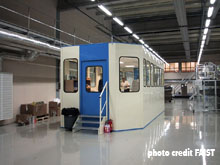The performance in terms of sound insulation of a cabin - construction specially designed to protect people (e.g. machine operators) from ambient noise, consisting of a fully enveloping structure - is very frequency dependent and is primarily related on the one hand to the performance of acoustic insulation panels (characterized by their sound reduction index) and also where appropriate to that of the silencer (for ventilation) and also to the number and to dimensions of cuts and openings, and on the other hand to the sealing imperfections and to structure born (bridging) sound transmissions.

the acoustical performance of a cabin depends on the weakest construction element |
|
|
This performance can be expressed in terms of difference (with and without the cabin) of overall A-weighted sound pressure levels or of sound pressure levels in octave bands at specified locations (such as maximum value at 1 m from the walls of the cabin, average value inside the cabin, value at a workplace) - also known as acoustic pressure reduction -.
For orders of magnitude (and with respect to a noise spectrum like "pink noise"), a level difference of up to 10 dBA can usually be obtained without special requirements, while a level difference from 10 to 20 dBA requires a standard cabin without important leakage, while a level difference of 20 to 30 dBA requires a standard cabin with sealing joints carefully implemented, a soundprrofing floor and a resilient mounting (cabin with a vibration control system), and while a difference of 30 to 40 dB involves high performance booths carefully designed and installed (a level difference even higher shall involve a special construction).
The prediction of acoustic performance (for airborne sound) of a cabin e.g. vertical walls - including doors, portholes and windows -, floor, roof can be performed with the simulation software SILDIS® (double or even triple depending on the number of layers assimilable to plates - steel, aluminum, gypsum, wood, glass - separated by porous media e.g. mineral or polyester wool but also: air). Overall performance is often impacted by the weakest element; the quality of design, construction and execution of assemblies is a key success factor.
Verification of acoustic performance of a cabin can be conducted in accordance with ISO 11957 Acoustics - Determination of sound insulation performance of cabins - Laboratory and in situ measurements